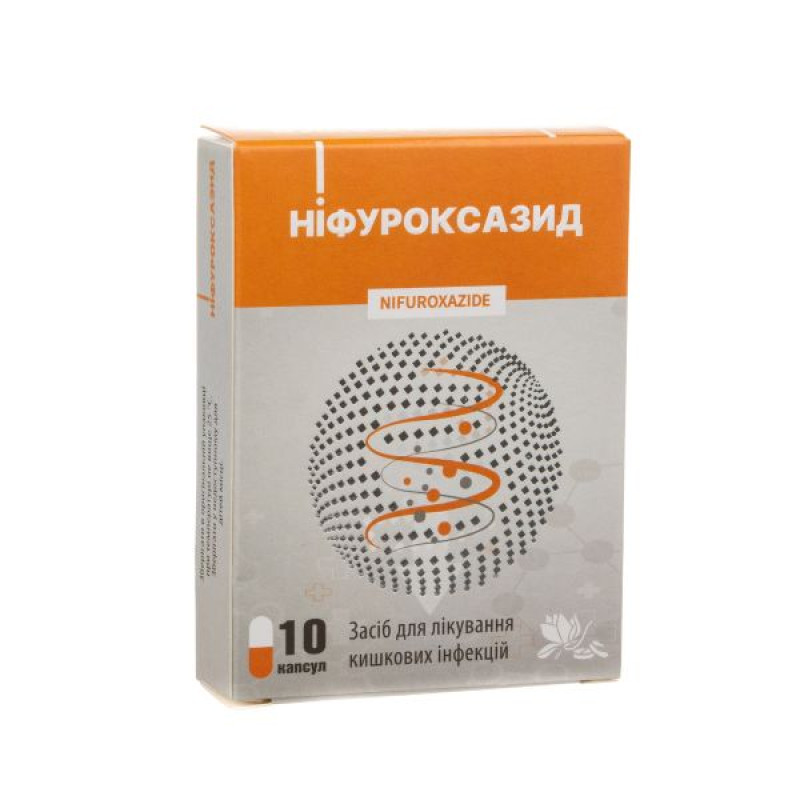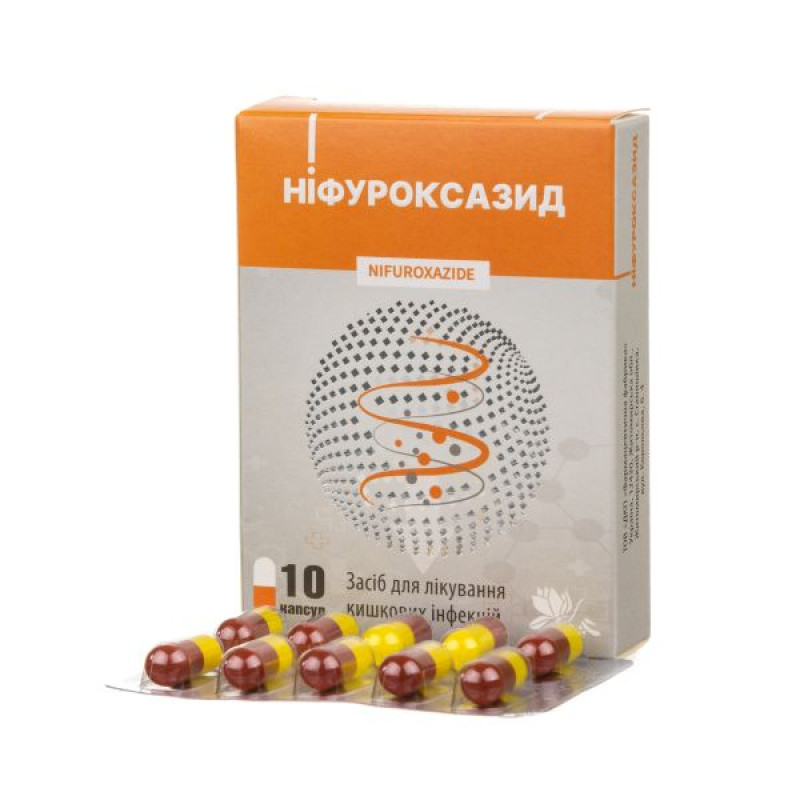Nifuroxazide capsules 200mg No. 10

Instructions for Nifuroxazide capsules 200mg No. 10
Composition
active ingredient: nifuroxazide;
1 capsule contains nifuroxazide - 200 mg;
excipients: microcrystalline cellulose, corn starch, sucrose, magnesium stearate;
Gelatin capsule: gelatin; titanium dioxide (E171), red iron oxide (E172), tartrazine (E102).
Dosage form
Capsules.
Main physicochemical properties: hard gelatin capsules with a yellow body and a red-brown cap. The contents of the capsules are bright yellow powder.
Pharmacotherapeutic group
Antimicrobial agents used for intestinal infections. Nifuroxazide. ATX code A07A X03.
Pharmacological properties
Pharmacodynamics.
Nifuroxazide is an antimicrobial drug, a derivative of nitrofuran. The mechanism of action is not fully understood. The antimicrobial and antiparasitic properties of nifuroxazide are probably due to the presence of an amino group. Local activity and lack of penetration into organs and tissues of the body make nifuroxazide unique compared to other nitrofuran derivatives, since there is no systemic effect of this antidiarrheal drug. Effective against gram-positive and gram-negative bacteria: Streptococcus pyogenes, Staphylococcus aureus, Escherichia coli, Salmonellae, Shigellae.
Pharmacokinetics.
Nifuroxazide after oral administration is partially absorbed (10-20%) from the gastrointestinal tract and is extensively metabolized, with the main components circulating in the blood being metabolites.
Nifuroxazide and its metabolites are excreted in the feces. The rate of excretion of metabolites depends on the amount of the drug taken and on the motility of the gastrointestinal tract. In general, the excretion of nifuroxazide is slow, it remains in the gastrointestinal tract for a long time.
In therapeutic doses, nifuroxazide practically does not suppress the normal intestinal microflora, does not cause the appearance of resistant microbial forms, as well as the development of cross-resistance of bacteria to other antibacterial drugs. The therapeutic effect is achieved from the first hours of treatment.
Preclinical safety data
Nifuroxazide demonstrates possible mutagenic potential.
The carcinogenic potential of nifuroxazide was evaluated in mice (50/sex/group) and rats (52/sex/group) that received nifuroxazide in the diet for 2 years at doses of 0, 200, 600 or 1800 mg/kg/day. Despite its mutagenic properties, the carcinogenicity of nifuroxazide was not proven in either mice or rats.
Nifuroxazide studies were conducted for two years in mice and rats at doses of 5400 mg/m2 and 10800 mg/m2, respectively, based on body surface area, which were 11 and 22 times, respectively, the maximum human dose of 1800 mg (493 mg/m2 for a patient weighing 60 kg).
Indication
Acute diarrhea of infectious etiology.
Contraindication
Hypersensitivity to nifuroxazide, other 5-nitrofuran derivatives or to other components of the drug.
Children under 6 years of age. For the treatment of children under 6 years of age, prescribe nifuroxazide in the form of a suspension.
Interaction with other medicinal products and other types of interactions
Nifuroxazide can be used in combination with drugs commonly used to treat diarrhea: rehydration solutions, antibiotics, chemotherapeutic drugs, antispasmodics, and painkillers.
Nifuroxazide is not recommended for use simultaneously with sorbents, drugs containing alcohol, drugs that may cause antabuse reactions, and drugs that depress the central nervous system.
Application features
Treatment with nifuroxazide does not exclude dietary regimen and rehydration. If diarrhea does not stop after 3 days of treatment, it is necessary to review the dosage and decide on rehydration. If necessary, use concomitant rehydration therapy depending on the age and condition of the patient and the intensity of diarrhea.
If oral or intravenous rehydration is prescribed, the instructions for dilution and use of the solutions intended for this purpose must be followed. If such rehydration is not necessary, fluid loss should be compensated by drinking plenty of drinks containing salt and sugar (based on an average daily requirement of 2 liters of water).
Dietary recommendations for diarrhea should be considered: avoid fresh vegetables and fruits, spicy foods, frozen foods and drinks. Rice should be preferred. The decision on the use of dairy products is made on a case-by-case basis.
If diarrhea is accompanied by clinical manifestations indicating aggressive phenomena (deterioration of the general condition, fever, symptoms of intoxication), nifuroxazide should be prescribed together with antibacterial drugs used to treat intestinal infections, since the drug is not absorbed in the intestine and does not enter the systemic circulation. The drug should not be prescribed as monotherapy for intestinal infections complicated by septicemia.
The gelatin capsule contains the dye tartrazine (E 102), which may cause allergic reactions.
During treatment, alcohol consumption is strictly prohibited due to the risk of developing a disulfiram-like reaction, which is manifested by exacerbation of diarrhea, vomiting, abdominal pain, a feeling of heat in the face and upper body, hyperemia, tinnitus, difficulty breathing, tachycardia.
Use during pregnancy or breastfeeding
Pregnancy
There are limited data on the use of nifuroxazide in pregnant women. Animal data on reproductive toxicity are insufficient. Nifuroxazide exhibits possible mutagenic potential. Therefore, nifuroxazide is not recommended for use during pregnancy and should not be administered to women of childbearing potential not using effective contraception.
Lactation
It is not known whether nifuroxazide or its metabolites are excreted in breast milk. Since nifuroxazide has low bioavailability (approximately 10-20% of the dose is absorbed from the gastrointestinal tract), its amount in milk is likely to be low. However, an effect on the gastrointestinal microbiome of breast-fed infants cannot be excluded. Due to the lack of clinical experience, the use of medicinal products containing nifuroxazide is not recommended during breastfeeding.
Fertility
Based on animal studies, there is insufficient information on the effects of nifuroxazide on fertility.
Ability to influence reaction speed when driving vehicles or other mechanisms
Does not affect the reaction speed when driving or using other mechanisms.
Method of administration and doses
Take orally, regardless of meals.
Adults and children over 15 years of age: 200 mg (1 capsule of 200 mg) 4 times a day. The maximum daily dose of nifuroxazide is 800 mg.
Children over 6 years old: 1 capsule of 200 mg 3-4 times a day. The daily dose of nifuroxazide is 600-800 mg.
The duration of treatment with Nifuroxazide 200 mg is no more than 3 days.
Children
For the treatment of children under 6 years of age, prescribe Nifuroxazide suspension.
Overdose
Cases of overdose have not been described. In case of overdose, gastric lavage and symptomatic treatment are recommended.
Adverse reactions
On the part of the immune system: allergic reactions are possible, including itching, skin rashes, urticaria, Quincke's edema, anaphylactic shock. The occurrence of an allergic reaction requires discontinuation of the drug. In the future, the patient should avoid taking nifuroxazide and other nitrofuran derivatives.
On the part of the gastrointestinal tract: temporary abdominal pain, nausea, vomiting, increased diarrhea may occur.
Expiration date
3 years.
Storage conditions
Store in the original packaging at a temperature not exceeding 25 ºС.
Keep out of reach of children.
Packaging
10 capsules in a blister, 1 or 2 blisters in a pack.
Vacation category
According to the recipe.
Producer
LLC "DKP "Pharmaceutical Factory".
Location of the manufacturer and its business address
Ukraine, 12430, Zhytomyr region, Zhytomyr district, Stanyshivka village, Koroleva st., bldg. 4.
There are no reviews for this product.
There are no reviews for this product, be the first to leave your review.
No questions about this product, be the first and ask your question.









